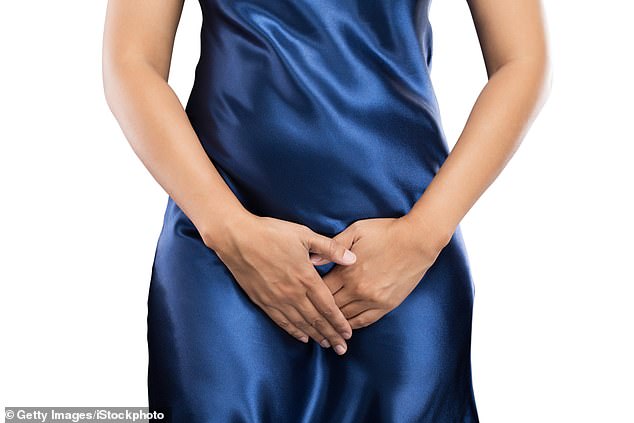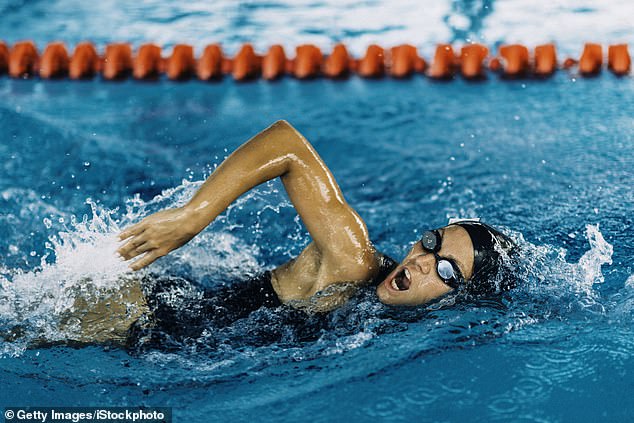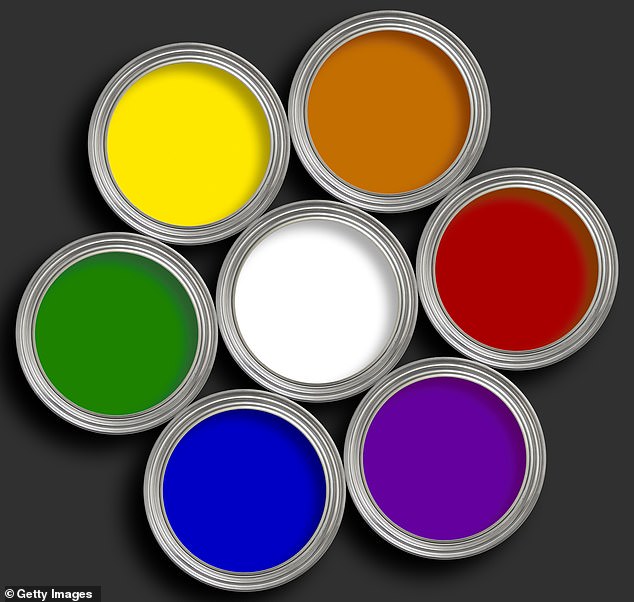HOW OFTEN SHOULD YOU PEE IN THE DAY?
The amount of urine we produce partly depends on the time of day. The ‘circadian rhythm’, or body clock, results in more urine being excreted during daylight hours. At night, the brain produces a chemical, antidiuretic hormone (ADH), which tells the kidneys to cut down the amount of urine produced to allow us to sleep.
However, factors such as age and medication can affect this.
‘Medication known as thiazide-type diuretics [taken to lower blood pressure] shouldn’t be taken any later than the afternoon, to prevent being woken at night to pass water,’ says Dr Nicholas Faure Walker, a consultant urologist at King’s College Hospital in London.
And with age we sleep less deeply and our circadian rhythms change so we can end up making urine at night and start needing to go to the loo. This becomes increasingly common in the over-60s.
So what is a normal number of times to pee during the day?
Our bladder can hold on average around 500ml — around two cups — of urine, but how often we take a pee (known medically as urinary frequency) can be affected by factors including age, and not just what or how much you have drunk.
‘It’s quite usual to pass water around three to five times a day if you drink around two litres daily,’ explains Vijay Sangar, a professor of urology at Manchester University.
But all sorts of things can affect that, he says. For example, spicy and acidic foods, such as curries and citrus fruits, can irritate the bladder and so increase the need to go.

The amount of urine we produce partly depends on the time of day

When the temperature drops, many people find they need frequent trips to the loo

Swimming makes you want to go too – due to a greater increase in blood volume going to the urinary organs because of the cold temperature of the water
… AND WHAT ABOUT AT NIGHT?
It’s not unusual to wake up needing the loo once or twice at night.
If you need to wee more frequently than this, in men it could be a sign of an enlarged prostate, a doughnut-shaped gland that sits around the urethra, which can put pressure on the bladder.
It may also be a symptom of diabetes. When there’s too much sugar in your blood, your kidneys have to work harder to get rid of it, which increases urine production.
‘Whether you’re a man or a woman, getting up more than twice a night is too much,’ says Christopher Eden, a consultant urological surgeon at London Bridge Hospital.
‘In general, it may be reduced by avoiding caffeine and alcohol late at night and by not drinking in the two hours before bedtime. But if it happens repeatedly then it should be investigated.’
PEE AFTER SEX — IF YOU’RE A WOMAN
Every year, around 1.6 million women in Britain suffer from urinary tract infections (UTIs) — and the bacteria responsible are often introduced as a result of sex.
That’s why it’s important for women to have a wee as soon as possible afterwards, says Dr Asiya Maula, a GP and director of The Health Suite clinic in Leicester.
‘During sex, bacteria can make their way into the urethra but urinating helps flush any out,’ she says.
‘If you don’t pee afterwards, bacteria can have a longer opportunity to multiply. It is good practice to pee within 30 minutes of sex to reduce the risk of contracting a UTI.’
And, contrary to popular belief, women’s urine is not sterile and contains E. coli, the pathogen responsible for 90 per cent of all UTIs, a 2018 study by Chicago Loyola University in the U.S. showed. After sex, bacteria can pass from the vagina to the bladder, where this E. coli rapidly multiplies.
However, the weeing-after-sex rule does not apply to men, says Professor Sangar. ‘Men have, if you like, distance. The gap between their bladder and the outside world via the urethra is 25 cm, while it’s only 3 cm long in women.
‘This means that any bacteria introduced into a man’s urethra would have to travel much further to cause infection.’
WEAK GRIP, WEAK PELVIC FLOOR
Grip strength is considered an indicator of overall muscle strength — and that includes the strength of your pelvic floor muscles, and in turn your risk of stress incontinence, according to new research.
A study of more than 4,000 people found that reduced grip strength was associated with a higher prevalence and severity of stress incontinence, reported the journal BMC Women’s Health last year.
‘Both poor grip strength and stress incontinence are probably related to sarcopenia [low muscle mass] and there will be lower muscle strength in the pelvic floor [controlling continence] as well as the hands and arms,’ says Dr Faure Walker.
To identify your pelvic floor, pull up and in as if you’re trying to stop passing wind and urine at the same time — pulling forward from the back passage.
To help strengthen your pelvic floor, do ten short squeezes, then a longer set of ten where you briefly hold each squeeze daily.
WOMEN SHOULD SIT ON THE SEAT — DON’T HOVER
It’s important for women to sit down and not hover over the seat when urinating, explains Professor Sohier Elneil, a consultant urogynaecologist at University College Hospital, London.
‘When we pass urine, the pelvic floor muscles must relax so the bladder can contract and the urethra, the tube which carries urine from the body, can open.
‘However, if you hover, this doesn’t happen as efficiently, which means that the bladder itself doesn’t empty as well.’
If urine is left in the bladder after urinating, the extra time allows any bacteria to multiply and increases the risk of causing an infection.
It is better to hold yourself as upright as possible when you
urinate, adds Mr Sachchidananda Maiti, a consultant gynaecologist and obstetrician at Manchester University NHS Foundation Trust and the private Pall Mall Medical.
He explains that if the angle between the urethra and bladder is narrow, then the urine can’t pass out easily, so you need to strain and push — which could ultimately lead to a hernia.
To reduce the angle and make it straighter, you need to relax your pelvic floor muscles, which is why it’s better to sit on the loo seat.
WHY MEN SHOULD SIT — IF IN A HURRY
Although men tend to stand up to empty their bladder, there is actually no need for them to do so, says Professor Christof Kastner, a consultant urologist at St Bartholomew’s Hospital, London.
‘The assumption that standing up is healthier is historical,’ he explains. In some cultures, sitting down to urinate is seen as more hygienic, as it reduces splashing.
However, those men who are in a hurry, or who struggle to empty their bladder fully, may want to sit if they have prostate problems.
A 2014 review of studies, by Leiden University Medical Centre in the Netherlands, found that men with prostate problems were able to empty their bladders faster and more effectively if they sat to pee.
Dr Faure Walker explains: ‘As the prostate lies at the base of the bladder, it can make it more difficult to pass water as it is a physical obstruction — and so there is a strain in trying to do so. If there is straining, it is easier to pass water if you’re sitting.’
However, standing up does make it easy to spot if there is an issue with the stream or flow of urine.
‘If the stream sprays, speak to your doctor as there might be underlying issues such as an obstruction or the foreskin becoming tight,’ says Dr Faure Walker. ‘This can be treated with manual manipulation or circumcision.’
WHY THE COLD MAKES YOU WANT TO GO
When the temperature drops, many people find they need frequent trips to the loo — and the reason is that the cold causes your blood vessels to constrict: this reduces blood flow to the skin, diverting it to the vital internal organs to keep your core warm.
‘But one consequence of the blood moving to the core is that more urine is produced, known as cold-induced diuresis,’ explains Dr Clare Eglin, a principal lecturer in human and applied physiology at Portsmouth University.
And whereas ‘in summer we keep water bottles at hand, in winter we often forget to drink regularly’, says Clare Thornton-Wood, a dietitian based in Sussex and spokesperson for the British Dietetic Association.
The net effect is dehydration.
To check if you are adequately hydrated, examine the colour of your urine. If it’s pale yellow, you are getting enough fluids. Darker urine suggests you may need to up your intake.
Meanwhile, when it’s cold, just moving around — even activities such as walking and household chores — will produce heat which will keep us warm, and in turn prevent excessive urination.
DON’T HOLD ON FOR TOO LONG
Sometimes, when busy, we can put off going to the loo. But holding in urine for too long means the bladder can become distended and ultimately less efficient at emptying, especially as we get older, explains Professor Elneil. ‘If the bladder has been repeatedly stretched in this way, it loses its tone and can’t contract as much and so doesn’t empty as well as it should, increasing susceptibility to infection.’
Dr Susanna Unsworth, a GP in Cambridge and women’s health expert, says: ‘Women have a shorter urethra than men, so bacteria can more readily travel up into the bladder. Regular emptying helps flush the bacteria out.
‘Holding urine in the bladder for too long can increase the risk of UTIs.’
TO EMPTY THE BLADDER, TRY THE ‘DOUBLE’ WEE
Even if you’re in a hurry, it’s important not to push or force yourself to urinate.
‘If you are forcing the wee out, then you are exerting pressure on the pelvic floor — and in women this could lead to issues such as prolapse,’ says Dr Maiti. This happens when the muscles and tissue in the pelvis weaken, causing the womb to drop into the vagina.
It’s important to give the bladder time to empty properly, adds Professor Kastner. ‘If you feel you are not emptying completely, make sure you have fully emptied by waiting a few seconds and then try to empty more,’ he says. This is known as double voiding.
AVOID ‘JUST IN CASE’ TRIPS TO THE LOO
It might be natural when you wake up in the night or before a long journey to try to empty your bladder ‘just in case’.
But repeatedly going when you don’t have the urge can make the bladder over-sensitive, says Professor Eden. As a result, you’ll find yourself needing to urinate when the bladder isn’t full.
He says: ‘Getting into the habit of constantly peeing leads to sensory urgency, in which the bladder is not full enough to need to be emptied but its owner misinterprets the signals coming from it. To use a central heating analogy, the thermostat is set too low.’
SWIMMING MAKES YOU WANT TO GO
You’ve just jumped in the water — but, within moments, you feel the need to pee.
Known as immersion diuresis, this is partly caused by greater increase in blood volume going to the organs because of the cold temperature of the water, explains Professor Elneil. This triggers a rise in blood pressure and, as a consequence, the kidneys start producing more urine.
‘There is also a neurological response — the fear or flight response — if you’re afraid, you suddenly want to pee and that is part of the mechanism.’
HOW LONG IT SHOULD TAKE
In 2013, U.S. scientists discovered that all mammals urinate for roughly the same amount of time — 21 seconds. If it frequently takes less or more than this, then you’re either holding it in for too long or going too often, which could need investigating.
A healthy bladder works best if the body just relaxes so that the bladder muscles naturally contract to let the urine flow. Age and gender can also affect how quickly we urinate, says consultant urologist Dr Nicholas Faure Walker.
‘Women can empty their bladders more quickly because the urethra is shorter. Normally, the bladder should be able to be emptied without straining but, in older people, the bladder can weaken, so trying to empty it in 21 seconds may cause straining, can aggravate hernias or cause prolapse in women.’
Should you be worried if your urine looks like this?

Beetroot and rhubarb can turn urine red. It could also be caused by blood from a urinary tract infection or prostate and kidney problems
RED: Beetroot and rhubarb can turn urine red. It could also be caused by blood from a urinary tract infection (UTI) or prostate and kidney problems, including cancer. While it usually has a minor cause, 20 per cent of people with painless blood in their urine receive a cancer diagnosis. Infections are usually painful. Always see your GP.
GREEN: Asparagus may make urine look green because, as with beetroot, some of us may not break down the pigment compounds in it. The drug propofol, a sedative used in surgery, can also turn urine green. This is due to the way the liver processes this drug in some people. The same colour change may be due to an infection caused by a pseudomonas bacteria, which can cause complications.
BLUE: Amitriptyline (used for depression) and indomethacin (a painkiller, and used to relieve symptoms of gout) can turn urine blue. As can an inherited condition, familial benign hypercalcemia, where gut bacteria break down an amino acid, creating blue ‘waste’.
BROWN: A brown hue may indicate dehydration. It can also be a sign of liver or kidney disorders, and rhabdomyolysis (destruction of muscle, for instance by intensive training — but this is rare). Some Parkinson’s drugs and antibiotics can darken urine, too.
ORANGE: Orange urine can be a warning of liver and/or kidney problems, such as obstructive jaundice. Here bile is excreted through the urine, rather than the stools, perhaps due to a gallstone or pancreatic or bile duct cancer.
PURPLE: This colour could be a sign of ‘purple urine bag’ syndrome, which can occur when patients with a catheter develop a UTI. Purple urine is also a characteristic of porphyria, a blood disorder which causes the body to make too much porphyrin, the substance that gives blood its colour.










